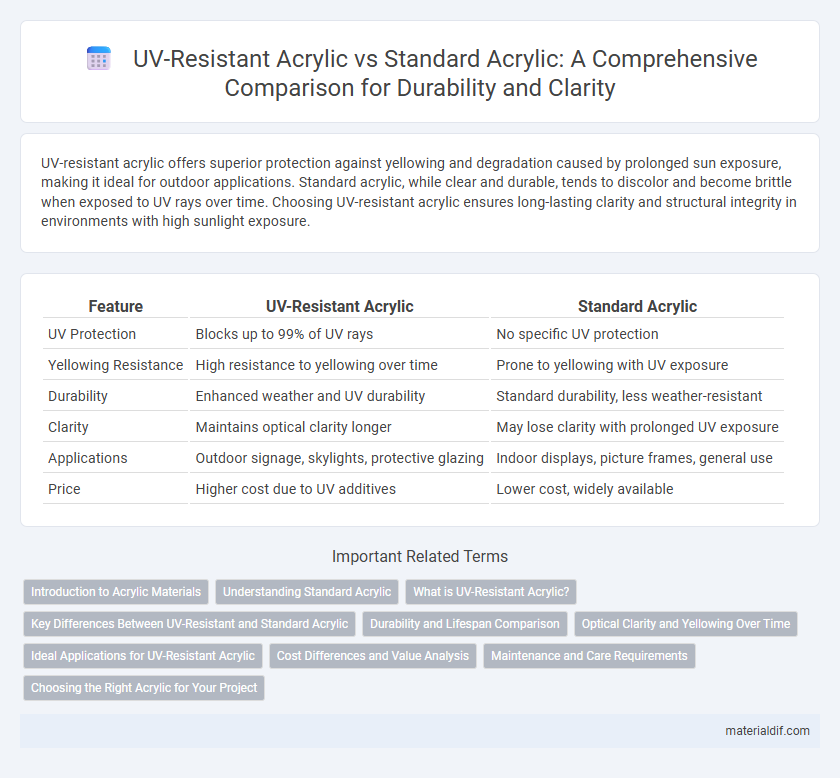UV-resistant acrylic offers superior protection against yellowing and degradation caused by prolonged sun exposure, making it ideal for outdoor applications. Standard acrylic, while clear and durable, tends to discolor and become brittle when exposed to UV rays over time. Choosing UV-resistant acrylic ensures long-lasting clarity and structural integrity in environments with high sunlight exposure.
Table of Comparison
| Feature | UV-Resistant Acrylic | Standard Acrylic |
|---|---|---|
| UV Protection | Blocks up to 99% of UV rays | No specific UV protection |
| Yellowing Resistance | High resistance to yellowing over time | Prone to yellowing with UV exposure |
| Durability | Enhanced weather and UV durability | Standard durability, less weather-resistant |
| Clarity | Maintains optical clarity longer | May lose clarity with prolonged UV exposure |
| Applications | Outdoor signage, skylights, protective glazing | Indoor displays, picture frames, general use |
| Price | Higher cost due to UV additives | Lower cost, widely available |
Introduction to Acrylic Materials
UV-resistant acrylic offers enhanced durability and longevity compared to standard acrylic by incorporating additives that block harmful ultraviolet rays, preventing yellowing and brittleness over time. Standard acrylic, commonly used for its clarity and impact resistance, lacks these UV-blocking properties, making it more susceptible to degradation when exposed to sunlight. The choice between UV-resistant and standard acrylic materials depends on exposure conditions and the need for prolonged optical clarity in outdoor applications.
Understanding Standard Acrylic
Standard acrylic, made from polymethyl methacrylate (PMMA), offers excellent clarity and weather resistance but lacks strong protection against UV radiation, which can cause yellowing and brittleness over time. Its molecular structure absorbs UV light, leading to degradation when exposed to prolonged sunlight without protective coatings. Compared to UV-resistant acrylic, standard acrylic is more affordable but requires additional treatments or films to enhance UV protection for outdoor applications.
What is UV-Resistant Acrylic?
UV-resistant acrylic is a specialized form of acrylic polymer enhanced with additives or coatings that protect it from degradation caused by ultraviolet (UV) radiation. Unlike standard acrylic, which can yellow, crack, or become brittle when exposed to prolonged sunlight, UV-resistant acrylic maintains clarity, strength, and color stability over time. This makes UV-resistant acrylic ideal for outdoor applications such as signage, skylights, and protective barriers where long-term exposure to sunlight occurs.
Key Differences Between UV-Resistant and Standard Acrylic
UV-resistant acrylic incorporates special additives or coatings that block harmful ultraviolet rays, preventing yellowing and degradation over time, whereas standard acrylic lacks this protection, leading to faster discoloration when exposed to sunlight. This enhanced durability makes UV-resistant acrylic ideal for outdoor applications where prolonged sun exposure occurs, while standard acrylic suits indoor or shaded environments. The difference in UV stability directly impacts the lifespan and clarity retention of acrylic products in exterior conditions.
Durability and Lifespan Comparison
UV-resistant acrylic contains special additives that significantly enhance its durability by preventing yellowing and degradation caused by prolonged sun exposure. Standard acrylic, while strong and clear, tends to become brittle and discolored after extended UV exposure, reducing its lifespan to around 5-10 years. UV-resistant acrylic can maintain its clarity and structural integrity for 15-20 years, making it a superior choice for outdoor applications requiring long-lasting performance.
Optical Clarity and Yellowing Over Time
UV-resistant acrylic offers superior optical clarity by reducing yellowing and maintaining transparency much longer than standard acrylic when exposed to sunlight. Standard acrylic tends to degrade faster, showing yellow discoloration that diminishes visual quality and light transmission. The enhanced UV stabilization in UV-resistant acrylic makes it ideal for applications requiring long-term clarity and durability under prolonged UV exposure.
Ideal Applications for UV-Resistant Acrylic
UV-resistant acrylic is ideal for outdoor signage, skylights, and greenhouse panels where prolonged sun exposure can cause standard acrylic to yellow and weaken. Its enhanced UV protection preserves clarity, color fidelity, and material strength, making it suitable for architectural glazing and automotive components. This durability extends the lifespan of products used in environments with intense UV radiation.
Cost Differences and Value Analysis
UV-resistant acrylic generally costs 20-40% more than standard acrylic due to its enhanced protective properties against sun damage and discoloration. The higher initial investment in UV-resistant acrylic offers long-term value by reducing maintenance, extending product lifespan, and preserving clarity in outdoor applications. Standard acrylic is a cost-effective option for indoor use where UV exposure and weathering are minimal, but may require more frequent replacement or cleaning when used outdoors.
Maintenance and Care Requirements
UV-resistant acrylic requires less frequent cleaning and is less prone to yellowing or cracking compared to standard acrylic, reducing long-term maintenance efforts. Its enhanced durability minimizes the need for protective coatings or frequent replacements, making it ideal for outdoor applications exposed to sunlight. Standard acrylic demands more careful handling to prevent surface degradation and typically needs regular polishing to maintain clarity.
Choosing the Right Acrylic for Your Project
UV-resistant acrylic offers superior protection against yellowing and degradation caused by prolonged sun exposure, making it ideal for outdoor applications and projects requiring long-term clarity. Standard acrylic, while more cost-effective, is best suited for indoor uses where exposure to UV light is minimal. Evaluating environmental conditions and project longevity is crucial when selecting between UV-resistant and standard acrylic to ensure durability and optimal performance.
UV-Resistant Acrylic vs Standard Acrylic Infographic

 materialdif.com
materialdif.com